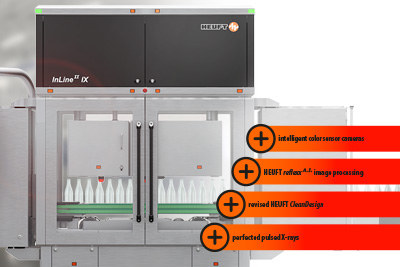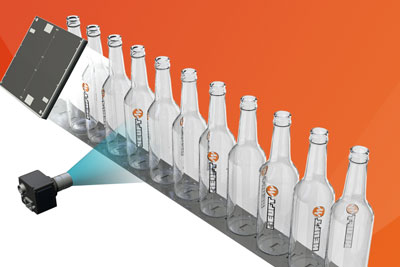Campari Group & HEUFT: Building more value together
Kejsi Carku graduated in food technology at University of Turin, wrote a feasibility study in close cooperation with HEUFT at Campari Group's Canale plant in northern Italy. It’s subject: the integration of a further empty bottle inspector in one of the filling lines there. One question in particular was in the foreground: is it at all possible to inspect a very special, unusually designed bottle without any gaps?
Taking a closer look at a Frangelico hazelnut liqueur bottle, you will recognize the appearance of a pious monk in its shape and embossing who is wearing a rope around his belly. Much more difficult to recognize are critical defects such as chips, cracks, wrinkles and inclusions in the glass, which can lead to glass breakage.
At first, Kejsi Carku, who already worked in quality control at Campari Group’s Canale plant during her studies, thought it would be impossible to find such defects in all areas of every single Frangelico primary packaging. "In fact, at first we were convinced that we wouldn't be able to inspect this bottle 100 percent and would have to give up some features," the university graduate recalls. "But fortunately, that turned out to be wrong. On the contrary. Thanks to this study, we now know that it's possible to inspect Frangelico with a high degree of accuracy."

Kejsi Carku
Food safety as the main criterion
Dr. Clara Molino, senior quality manager at Campari Group, who helped supervise Kejsi Carku’s work and provided intensive support, agrees: "The main concern we have with glass bottles is food safety. With the empty bottle inspector, we will be able to reject any bottles that don't meet our requirements." Containers that are contaminated with glass fragments or affected by critical defects are not allowed to enter the line in the first place. "However, we also take into account technical and aesthetic defects and have agreed specifications with glass suppliers that must be met. The results of this study are also important in this context."
For Sandra Persano, quality manager in charge at Campari Group's Canale plant on site, such a high-performance empty bottle inspector is also "a necessity and its implementation in every line a must for the standardization of all our equipment in the long term. The next one to be integrated is the one in line 1." In addition to less complex designed white glass containers of different formats, three different sizes of the "difficult to inspect" monk-shaped amber glass bottles are filled with Frangelico there. For this reason, she had suggested to the young colleague that she makes the project the subject of her university thesis and supported her in word and deed during the planning and implementation – a rare opportunity for an exceptionally practical approach!

Real fault bottles as test objects
"We worked out the study using real glass faults collected at the Canale plant," confirms Kejsi Carku. The result: a much more realistic and accurate calibration of the inspector than would have been possible with merely artificially created defects. As expected the Frangelico bottles presented the HEUFT InLine II system with great challenges in this respect. This concerns for example the complete illumination of the empty containers without shadows or their exact centering for the unrestricted finish and thread inspection – and above all the elliptical bases with which the container rotation for the fully covering sidewall inspection is not quite as easy to realize as with standard cylindrical bottles. Thanks to specific adjustments to the inspector, however, these problems have been completely solved, says Kejsi Carku.
This applies in particular with regard to a specially designed special module with a "V-shaped" arrangement of the transport belts in the device, "which guarantees sufficient rotation for sidewall inspection." The fact that this makes complete coverage of the liquor bottles possible is one of the most important results of the intensive series of tests which it completed together with genuine experts at the HEUFT SYSTEMTECHNIK GMBH headquarters in Germany.

HEUFT experts as problem solvers
"I was very enthusiastic about the research centre in Burgbrohl and the cooperation I was able to experience there", she recalls. Both Martina Frey, the HEUFT product manager responsible for empty bottle inspectors, and Thomas Feldkötter from the leading supplier's test department worked with her full time for a whole week on the project to develop a solution for the all-surface inspection of all the empty containers in Line 1 at Campari Group’s Canale plant – including those for the Frangelico liqueur. To this end they both explained to her in detail how modular HEUFT InLine II empty bottle inspectors work and the detection technologies available as well as completing extensive test and optimization runs with her.
"It was impressive for me to see two such professional personalities working together in harmony and pursuing the same goal," recalls Kejsi Carku. Thus with the help of the intelligent HEUFT reflexx A.I. image processing good objects such as glass embossings belonging to the bottle design were taught in and specific masks were set which divide the Frangelico bottles into different inspection zones. This means that smart filters can now be applied to enable areas that are difficult to inspect to be examined even more closely and with higher resolution, and to specifically increase the sensitivity of defect detection.

Cooperation as a win-win situation
With success: "Of the tested bottles with real defects (metal inclusions at the mouth, thread breakouts and glass deformations)," the final thesis states, all were "correctly detected." For Kejsi Carku, this is a "promising result, especially because the defects are located in three different areas of the bottles and are detected by three different modules." She added that this means that all critical defects and deviations can now be reliably recognized in all areas of the Frangelico primary packaging despite their unmistakable design. "Thanks to HEUFT we now know that 100 percent inspection is possible and nothing is left out."
In addition, she says that the cooperation on the case study helped to avoid potential problems and an excessive amount of time during the upcoming installation of the system right from the start. Accordingly Kejsi Carku assesses the cooperation as "very valuable" and is sure that a "win-win situation for HEUFT and the Campari Group can result from it" – with precisely fitting standardized systems for the most varied of applications and filling lines worldwide. More than a dozen empty bottle inspectors have already been installed at various locations of the important spirits producer.

Study results as best practice
And that's where the aforementioned high standards in terms of packaging integrity and product safety apply. In particular, all primary packaging must "comply with legal requirements and industry best practices," according to the group's quality philosophy. Kejsi Carku’s feasibility study thus demonstrates in a practical way an optimal approach to the complete inspection of the unusual Frangelico bottles. Accordingly, she reports, it has been positively evaluated not only by the University of Turin.
"At Campari Group my thesis was also appreciated," reveals the now permanent Quality Performance employee. Especially because it was "a real project for the future of the company." The joint path that the two partners embarked on some time ago can thus be continued in a future-proof manner. Dr Clara Molino also confirms this: "There has been a ten-year cooperation between HEUFT and Campari Group which we assess positively. We consider the inspector to be an important feature for the food safety of our products and assume that the cooperation will be further expanded and become increasingly efficient."

Dr Clara Molino




